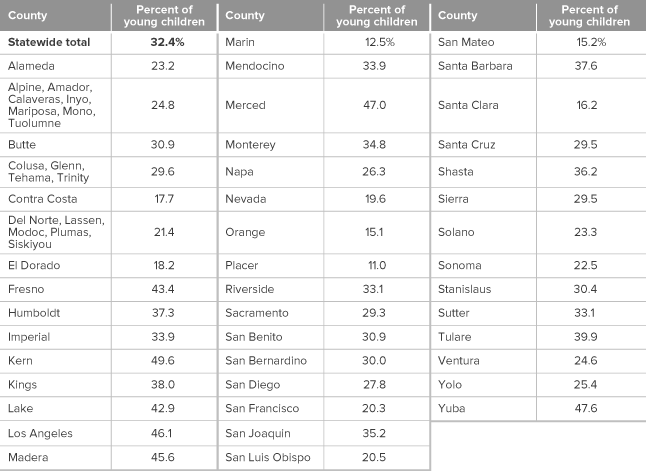- WIC promotes nutrition and health for new mothers, pregnant women, and young children.
The federally funded Special Supplemental Nutrition Program for Women, Infants, and Children (WIC) is supervised in California by the state Department of Public Health and administered by 84 local WIC agencies. It is the state’s third largest federal nutrition program after CalFresh, California’s food stamp program, and subsidized school meals. In the 2014 federal fiscal year, it provided more than $764 million in food benefits to Californians. Research has found that WIC boosts infant birth weight, encourages breastfeeding, and promotes child health. - WIC helps California’s most vulnerable residents.
WIC supports pregnant women, those who have recently given birth, and young children who have low incomes. Women are eligible during pregnancy and up to six months after birth. Children are eligible from birth to age 5. To qualify, participants must show they are currently enrolled in Medi-Cal health insurance, CalWORKs cash assistance, or CalFresh nutrition assistance. Alternatively, they are eligible if their income is under 185% of the federal poverty line, currently $44,863 for a family of four. In addition, applicants are evaluated for nutrition and health risks. WIC participants must purchase specific foods (for example, milk and eggs) using vouchers and attend classes that encourage healthy eating and support breastfeeding. They may also be referred to other social services. - California has the highest coverage rate in the nation.
California’s average monthly WIC enrollment was nearly 1.4 million women, infants, and children in the 2014 federal fiscal year. Nearly 80% of recipients are children. Estimates indicate that 82.1% of Californians eligible for WIC received benefits in 2012. That represented the highest coverage rate in the country and was well above the national rate of 63.1%. California’s coverage rate has consistently been above the national rate and has been increasing every year since 2009, when it was 73.7%. - WIC child enrollment levels vary by county.
In California’s 2014 fiscal year, 32.4% of all young children received WIC. Enrollment levels varied considerably across counties. The largest shares of children receiving WIC benefits lived in Kern (49.6%), Yuba (47.6%), Merced (47.0%), and Los Angeles (46.1%) Counties. Relatively fewer children participated in Placer (11.0%), Marin (12.5%), and Orange (15.1%) Counties. - Latinos represent the largest share of WIC recipients in California.
Because Latinos comprise the largest share of California’s low-income young children, they make up the highest percentage of WIC recipients. Latinos made up 77.9% of women, 65.7% of infants, and 72.9% of children enrolled in WIC in 2011–12. Whites came next, accounting for 12.2% of women, 18.1% of infants, and 15.3% of children. Indeed, shares of low-income young children in California are essentially identical to shares on WIC: Latinos made up 69.1% of all young children living in families with incomes less than 250% of the federal poverty level (or $57,625 for a family of four). Whites made up 15.2% of young children approximately income eligible for WIC. All other racial groups combined comprised 15.8% of such young children.
Latinos make up the majority of young children on WIC

SOURCE: Author’s calculations from the 2012 American Community Survey.
- Many WIC recipients also participate in other safety net programs.
The local administration of WIC and the fact that women become eligible during pregnancy mean that the program can serve the important function of connecting young children to other social services. Nationally, more than 90% of pregnant women participating in WIC are enrolled by their second trimester, while 92.5% of WIC infants are enrolled before three months of age. Most WIC participants in California report they are insured through Medi-Cal—among young children on WIC in 2012, 71.6% were on Medi-Cal and 58.1% received benefits from CalFresh.
WIC enrollment levels vary across the state

SOURCES: Author’s calculations from the Surveillance, Epidemiology and End Results Program (SEER) county level population files for children under age 6 (2013); California Department of Public Health administrative data (FY 2014).
NOTE: Counties with no local WIC agencies are grouped with nearby counties.
SOURCES: California Department of Public Health administrative data and website; United States Department of Agriculture Food and Nutrition Service national and state estimates for WIC; California Health Interview Survey; Surveillance, Epidemiology, and End Results Program (SEER) county level population files; author’s calculations from the 2012 American Community Survey; Currie, Janet & Rossin-Slater, Maya. Early-Life Origins of Life-cycle well-being: Research and policy implications (2015). Journal of Policy Analysis and Management.
Topics
Health & Safety Net Population




